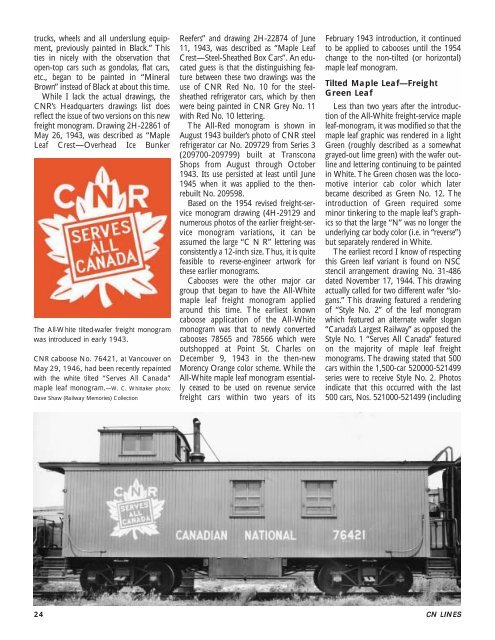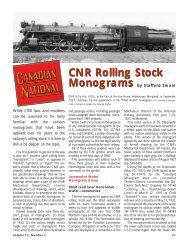CN LINES V12N3 - Canadian National Railways Historical Association
CN LINES V12N3 - Canadian National Railways Historical Association
CN LINES V12N3 - Canadian National Railways Historical Association
Create successful ePaper yourself
Turn your PDF publications into a flip-book with our unique Google optimized e-Paper software.
trucks, wheels and all underslung equipment,<br />
previously painted in Black.” This<br />
ties in nicely with the observation that<br />
open-top cars such as gondolas, flat cars,<br />
etc., began to be painted in “Mineral<br />
Brown” instead of Black at about this time.<br />
While I lack the actual drawings, the<br />
<strong>CN</strong>R’s Headquarters drawings list does<br />
reflect the issue of two versions on this new<br />
freight monogram. Drawing 2H-22861 of<br />
May 26, 1943, was described as “Maple<br />
Leaf Crest—Overhead Ice Bunker<br />
The All-White tilted-wafer freight monogram<br />
was introduced in early 1943.<br />
<strong>CN</strong>R caboose No. 76421, at Vancouver on<br />
May 29, 1946, had been recently repainted<br />
with the white tilted “Serves All Canada”<br />
maple leaf monogram.—W. C. Whittaker photo;<br />
Dave Shaw (Railway Memories) Collection<br />
Reefers” and drawing 2H-22874 of June<br />
11, 1943, was described as “Maple Leaf<br />
Crest—Steel-Sheathed Box Cars”. An educated<br />
guess is that the distinguishing feature<br />
between these two drawings was the<br />
use of <strong>CN</strong>R Red No. 10 for the steelsheathed<br />
refrigerator cars, which by then<br />
were being painted in <strong>CN</strong>R Grey No. 11<br />
with Red No. 10 lettering.<br />
The All-Red monogram is shown in<br />
August 1943 builder’s photo of <strong>CN</strong>R steel<br />
refrigerator car No. 209729 from Series 3<br />
(209700-209799) built at Transcona<br />
Shops from August through October<br />
1943. Its use persisted at least until June<br />
1945 when it was applied to the thenrebuilt<br />
No. 209598.<br />
Based on the 1954 revised freight-service<br />
monogram drawing (4H-29129 and<br />
numerous photos of the earlier freight-service<br />
monogram variations, it can be<br />
assumed the large “C N R” lettering was<br />
consistently a 12-inch size. Thus, it is quite<br />
feasible to reverse-engineer artwork for<br />
these earlier monograms.<br />
Cabooses were the other major car<br />
group that began to have the All-White<br />
maple leaf freight monogram applied<br />
around this time. The earliest known<br />
caboose application of the All-White<br />
monogram was that to newly converted<br />
cabooses 78565 and 78566 which were<br />
outshopped at Point St. Charles on<br />
December 9, 1943 in the then-new<br />
Morency Orange color scheme. While the<br />
All-White maple leaf monogram essentially<br />
ceased to be used on revenue service<br />
freight cars within two years of its<br />
February 1943 introduction, it continued<br />
to be applied to cabooses until the 1954<br />
change to the non-tilted (or horizontal)<br />
maple leaf monogram.<br />
Tilted Maple Leaf—Freight<br />
Green Leaf<br />
Less than two years after the introduction<br />
of the All-White freight-service maple<br />
leaf-monogram, it was modified so that the<br />
maple leaf graphic was rendered in a light<br />
Green (roughly described as a somewhat<br />
grayed-out lime green) with the wafer outline<br />
and lettering continuing to be painted<br />
in White. The Green chosen was the locomotive<br />
interior cab color which later<br />
became described as Green No. 12. The<br />
introduction of Green required some<br />
minor tinkering to the maple leaf’s graphics<br />
so that the large “N” was no longer the<br />
underlying car body color (i.e. in “reverse”)<br />
but separately rendered in White.<br />
The earliest record I know of respecting<br />
this Green leaf variant is found on NSC<br />
stencil arrangement drawing No. 31-486<br />
dated November 17, 1944. This drawing<br />
actually called for two different wafer “slogans.”<br />
This drawing featured a rendering<br />
of “Style No. 2” of the leaf monogram<br />
which featured an alternate wafer slogan<br />
“Canada’s Largest Railway” as opposed the<br />
Style No. 1 “Serves All Canada” featured<br />
on the majority of maple leaf freight<br />
monograms. The drawing stated that 500<br />
cars within the 1,500-car 520000-521499<br />
series were to receive Style No. 2. Photos<br />
indicate that this occurred with the last<br />
500 cars, Nos. 521000-521499 (including<br />
24 <strong>CN</strong> <strong>LINES</strong>



